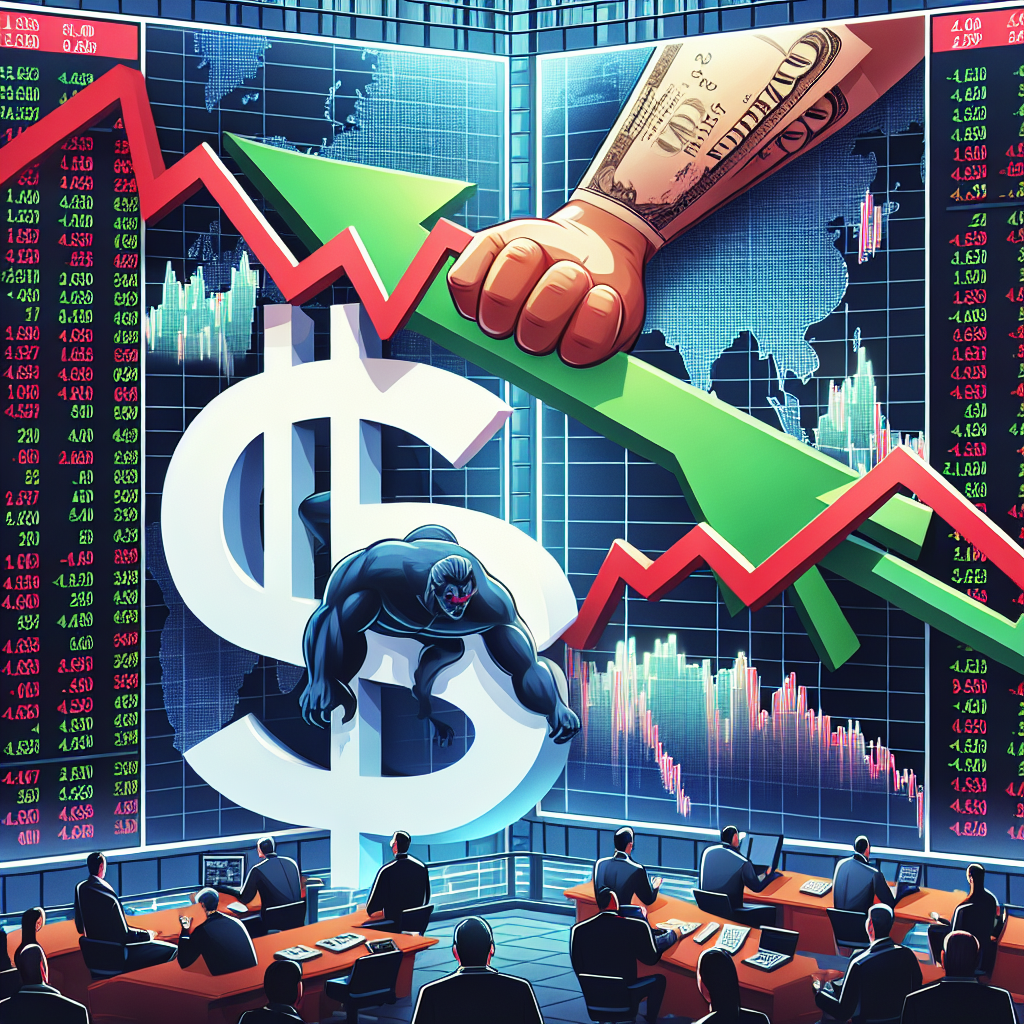“European Stocks Ascend: Riding the Wave of Dollar-Driven Asian Market Shifts”
Introduction
European stocks are set to rise as the trading week begins, buoyed by investor optimism and favorable economic indicators across the continent. This positive momentum comes in contrast to the challenges faced by Asian markets, where a strengthening U.S. dollar is exerting downward pressure. The dollar’s appreciation, driven by robust U.S. economic data and expectations of continued monetary tightening by the Federal Reserve, has led to capital outflows from emerging markets in Asia, causing volatility and uncertainty. Meanwhile, European equities are benefiting from a combination of resilient corporate earnings, easing energy prices, and supportive fiscal policies, positioning them for potential gains despite the global economic headwinds. As investors navigate these divergent market dynamics, the focus will remain on central bank actions, currency fluctuations, and geopolitical developments that could influence the trajectory of global financial markets.
Impact Of Dollar Strength On European Stock Markets
The recent fluctuations in global currency markets have brought the strength of the U.S. dollar into sharp focus, with significant implications for stock markets across different regions. As the dollar continues to exert pressure on Asian markets, European stocks appear poised for a potential climb. This dynamic is largely driven by the interplay between currency valuations and investor sentiment, which can significantly influence market movements.
The U.S. dollar’s strength has been a defining feature of the global financial landscape in recent months. A robust dollar often leads to a tightening of financial conditions in emerging markets, particularly in Asia, where many economies are heavily reliant on dollar-denominated debt. As the dollar appreciates, the cost of servicing this debt increases, leading to capital outflows and putting downward pressure on local stock markets. Consequently, Asian equities have experienced volatility, with investors reassessing their positions in light of these currency pressures.
In contrast, European markets are positioned to benefit from the dollar’s ascendancy. A strong dollar typically results in a weaker euro, which can be advantageous for European exporters. When the euro depreciates against the dollar, European goods become more competitively priced in international markets, potentially boosting export-driven sectors. This scenario can lead to increased revenues for European companies with significant exposure to global markets, thereby enhancing their stock performance.
Moreover, the European Central Bank’s monetary policy stance plays a crucial role in shaping market expectations. With the ECB maintaining a relatively accommodative policy compared to the U.S. Federal Reserve, the interest rate differential between the eurozone and the United States further supports the dollar’s strength. This divergence in monetary policy can attract capital flows into European equities, as investors seek to capitalize on the potential for higher returns in a low-interest-rate environment.
Additionally, the geopolitical landscape adds another layer of complexity to the situation. Trade tensions and economic uncertainties in Asia may prompt investors to seek safer havens for their capital. European markets, with their perceived stability and robust regulatory frameworks, can serve as attractive alternatives for global investors looking to diversify their portfolios. This shift in investment flows can provide additional support for European stocks, contributing to their upward trajectory.
Furthermore, the sectoral composition of European stock markets may also play a role in their resilience. The presence of strong industrial and consumer goods sectors, which are less sensitive to currency fluctuations compared to technology-heavy markets, can provide a buffer against external shocks. As a result, European equities may exhibit relative stability even amidst global market turbulence.
In conclusion, while the strength of the U.S. dollar poses challenges for Asian markets, it simultaneously creates opportunities for European stocks. The interplay between currency dynamics, monetary policy, and investor sentiment underscores the complex nature of global financial markets. As European companies potentially benefit from a weaker euro and attract capital inflows, their stock markets are well-positioned to climb. However, investors must remain vigilant, as the ever-evolving geopolitical and economic landscape can swiftly alter market conditions. By understanding these interconnected factors, market participants can better navigate the opportunities and risks presented by the current financial environment.
European Stocks: A Safe Haven Amidst Asian Market Volatility
As global financial markets navigate a complex landscape, European stocks are emerging as a potential safe haven amidst the volatility currently affecting Asian markets. This shift in investor sentiment is largely driven by the strengthening of the U.S. dollar, which has exerted considerable pressure on Asian economies. Consequently, investors are increasingly looking towards Europe, where economic stability and growth prospects appear more favorable.
The recent appreciation of the U.S. dollar has been a double-edged sword for global markets. On one hand, it reflects the robust performance of the U.S. economy, bolstered by strong employment figures and consumer spending. On the other hand, it has created significant challenges for Asian markets, where many countries rely heavily on exports priced in dollars. As the dollar strengthens, these exports become more expensive and less competitive on the global stage, leading to trade imbalances and economic strain.
In contrast, European markets have shown resilience in the face of these global pressures. The euro, while also affected by the dollar’s rise, has not experienced the same level of volatility as many Asian currencies. This relative stability has made European stocks more attractive to investors seeking to mitigate risk. Furthermore, the European Central Bank’s cautious approach to monetary policy has provided additional reassurance, as it continues to prioritize economic growth and stability over aggressive interest rate hikes.
Moreover, Europe’s economic outlook remains promising, with several key indicators pointing towards sustained growth. The region has benefited from a resurgence in consumer confidence, driven by declining unemployment rates and rising wages. Additionally, the European Union’s commitment to green energy and digital transformation has spurred investment in these sectors, creating new opportunities for growth and innovation. These factors have contributed to a positive investment climate, further enhancing the appeal of European stocks.
Another factor contributing to the attractiveness of European markets is the diversification they offer. While Asian markets are often dominated by technology and manufacturing sectors, Europe boasts a more balanced portfolio, with strong representation in finance, healthcare, and consumer goods. This diversification provides a buffer against sector-specific downturns, making European stocks a more stable investment option in uncertain times.
Furthermore, geopolitical considerations are also playing a role in shifting investor focus towards Europe. The ongoing trade tensions between the U.S. and China have created an unpredictable environment for Asian markets, prompting investors to seek alternatives. Europe’s relative political stability and its strong trade relationships with both the U.S. and China position it as a more reliable partner in the global economy.
In conclusion, as the U.S. dollar continues to exert pressure on Asian markets, European stocks are increasingly being viewed as a safe haven for investors. The combination of economic stability, promising growth prospects, and diversification makes Europe an attractive destination for those looking to navigate the current market volatility. While challenges remain, particularly in the form of potential geopolitical disruptions and the ongoing impact of global inflation, the outlook for European stocks remains positive. As investors continue to reassess their portfolios in light of these dynamics, Europe stands poised to benefit from this shift in sentiment, offering a beacon of stability in an otherwise turbulent financial landscape.
Key European Sectors Benefiting From Dollar Pressure On Asia
As the global financial landscape continues to evolve, European stocks are positioned to benefit from the current pressures facing Asian markets, particularly due to the strengthening of the U.S. dollar. This dynamic is creating a ripple effect across various sectors in Europe, offering unique opportunities for growth and investment. The interplay between currency fluctuations and market performance is a complex one, yet it is crucial to understand how these elements interact to shape economic outcomes.
The appreciation of the U.S. dollar has placed significant pressure on Asian markets, as many Asian economies are heavily reliant on exports priced in dollars. This situation has led to increased costs for Asian exporters, thereby affecting their competitiveness on the global stage. Consequently, European companies, particularly those in sectors such as manufacturing, technology, and consumer goods, are poised to capitalize on this shift. As Asian goods become more expensive, European products may gain a competitive edge, potentially increasing their market share in international trade.
Moreover, the strong dollar has implications for European tourism and luxury goods sectors. With the dollar’s strength making travel and luxury purchases more expensive for American consumers in Asia, Europe stands to benefit as an attractive alternative. The continent’s rich cultural heritage and diverse offerings make it a desirable destination, and the relative affordability compared to Asian markets could lead to an influx of tourists. This, in turn, would boost revenues for European hospitality, retail, and luxury brands, further enhancing their market position.
In addition to these sectors, the European energy market is also experiencing favorable conditions due to the dollar’s impact on Asia. As energy prices are typically denominated in dollars, a stronger dollar can lead to higher costs for Asian countries that import energy. This scenario presents an opportunity for European energy companies to expand their influence and secure more favorable trade agreements. Furthermore, Europe’s ongoing transition towards renewable energy sources positions it as a leader in sustainable energy solutions, potentially attracting investment from regions seeking to diversify their energy portfolios.
Financial services in Europe are another sector that stands to gain from the current economic climate. With the dollar’s strength creating volatility in Asian markets, investors may seek stability and diversification in European financial instruments. European banks and investment firms could see increased demand for their services, as they offer a relatively stable environment amidst global uncertainties. This influx of capital could lead to enhanced liquidity and growth prospects for the European financial sector.
While the strengthening dollar presents challenges for Asian markets, it simultaneously opens doors for European sectors to thrive. The interconnectedness of global economies means that shifts in one region can have far-reaching effects, and European companies are well-positioned to leverage these changes to their advantage. By understanding the nuances of currency fluctuations and their impact on trade and investment, European businesses can strategically navigate the current landscape to achieve growth and success.
In conclusion, the current economic environment, characterized by a strong U.S. dollar and its pressure on Asian markets, presents a unique set of opportunities for key European sectors. From manufacturing and technology to tourism and energy, European companies are poised to benefit from these dynamics. As global markets continue to adapt to these changes, the ability of European businesses to capitalize on these opportunities will be crucial in shaping their future success.
Investment Strategies: Capitalizing On European Market Resilience

As global investors navigate the complexities of international markets, the current economic landscape presents a unique opportunity to capitalize on the resilience of European stocks. While the strength of the U.S. dollar exerts pressure on Asian markets, European equities are poised for growth, offering a promising avenue for investment strategies. This divergence in market performance underscores the importance of geographical diversification in investment portfolios.
The robust performance of European stocks can be attributed to several key factors. Firstly, the European Central Bank’s monetary policy has played a crucial role in stabilizing the region’s economy. By maintaining low interest rates and implementing quantitative easing measures, the ECB has fostered an environment conducive to growth. This has bolstered investor confidence, leading to increased capital inflows into European markets. Furthermore, the gradual economic recovery in the Eurozone, driven by strong consumer spending and industrial production, has provided a solid foundation for corporate earnings growth.
In contrast, the appreciation of the U.S. dollar has created headwinds for Asian markets. A stronger dollar makes exports from Asian countries more expensive, thereby reducing their competitiveness on the global stage. This has led to a slowdown in economic growth across the region, with countries like China and Japan experiencing significant challenges. Consequently, investors are increasingly looking towards Europe as a more stable and attractive investment destination.
Moreover, the geopolitical landscape in Europe has shown signs of stabilization, further enhancing the appeal of European stocks. The resolution of Brexit-related uncertainties and the strengthening of political cohesion within the European Union have contributed to a more predictable business environment. This stability is particularly appealing to investors seeking to mitigate risks associated with geopolitical volatility.
In addition to these macroeconomic factors, sector-specific opportunities within Europe present compelling investment prospects. The region is home to a diverse range of industries, including technology, healthcare, and renewable energy, which are poised for significant growth. European companies in these sectors are at the forefront of innovation, benefiting from strong research and development capabilities and supportive government policies. As a result, investors can tap into these growth areas to enhance their portfolio returns.
Transitioning from a global perspective to a more localized focus, it is essential for investors to consider the specific dynamics of individual European markets. Countries such as Germany, France, and the Netherlands offer distinct investment opportunities, each with its own set of economic drivers and challenges. By conducting thorough market analysis and leveraging local expertise, investors can identify undervalued stocks and capitalize on market inefficiencies.
In conclusion, the current economic environment presents a compelling case for investing in European stocks. The resilience of the region’s markets, supported by favorable monetary policies, economic recovery, and geopolitical stability, positions Europe as an attractive investment destination. As the U.S. dollar continues to exert pressure on Asian markets, investors can benefit from diversifying their portfolios by allocating capital to European equities. By adopting a strategic approach and focusing on sector-specific opportunities, investors can capitalize on the growth potential of European markets and achieve long-term financial success.
European Companies With Strong Growth Potential In A Shifting Global Economy
In the ever-evolving landscape of the global economy, European companies are increasingly capturing the attention of investors, particularly as the dollar’s strength exerts pressure on Asian markets. This shift in focus is not merely a reaction to currency fluctuations but also a recognition of the robust growth potential inherent in several European sectors. As the dollar continues to appreciate, Asian markets face challenges that could redirect investment flows towards Europe, where companies are demonstrating resilience and adaptability in a shifting economic environment.
One of the key factors contributing to the attractiveness of European stocks is the region’s commitment to innovation and sustainability. European companies, particularly in the technology and renewable energy sectors, are at the forefront of developing cutting-edge solutions that address global challenges such as climate change and digital transformation. For instance, the European Union’s Green Deal and digital strategy have provided a conducive environment for companies to thrive, fostering a culture of innovation that is appealing to investors seeking long-term growth opportunities.
Moreover, the European financial sector is undergoing a transformation that positions it well for future growth. With the implementation of regulatory reforms and the adoption of digital banking solutions, European financial institutions are enhancing their operational efficiencies and customer experiences. This modernization is not only attracting domestic investors but also drawing interest from international markets, as these institutions are perceived as stable and forward-thinking.
In addition to technological advancements, the healthcare sector in Europe is also poised for significant growth. The continent is home to some of the world’s leading pharmaceutical companies, which are investing heavily in research and development to bring new therapies and medical technologies to market. The aging population in Europe, coupled with increasing healthcare demands globally, presents a substantial opportunity for these companies to expand their market share and drive revenue growth.
Furthermore, the luxury goods sector in Europe continues to demonstrate resilience, even in the face of economic uncertainties. European brands are synonymous with quality and craftsmanship, and their global appeal remains strong. As consumer preferences evolve, these companies are adept at leveraging digital platforms to reach new audiences and maintain their competitive edge. This adaptability ensures that European luxury brands remain a compelling investment option.
While the dollar’s strength poses challenges for Asian markets, it also presents an opportunity for European exporters to capitalize on favorable exchange rates. This advantage can enhance the competitiveness of European goods and services on the global stage, potentially boosting export revenues and supporting economic growth within the region.
In conclusion, as the global economy navigates through a period of transition, European companies are well-positioned to capitalize on emerging opportunities. Their commitment to innovation, sustainability, and adaptability, coupled with favorable economic conditions, makes them attractive to investors seeking growth potential. As the dollar continues to exert pressure on Asian markets, the spotlight on European stocks is likely to intensify, offering a promising outlook for the region’s economic future. Through strategic investments and a focus on long-term growth, European companies are poised to thrive in a shifting global economy, reinforcing their status as key players on the international stage.
Currency Fluctuations: Opportunities For European Investors
The global financial landscape is constantly shifting, influenced by a myriad of factors that include geopolitical events, economic data releases, and currency fluctuations. Recently, the dynamics between the U.S. dollar and Asian markets have garnered significant attention, presenting both challenges and opportunities for investors worldwide. As the dollar strengthens, Asian markets are experiencing increased pressure, a development that European investors are keenly observing. This scenario, while complex, offers potential opportunities for those invested in European stocks.
The U.S. dollar’s recent appreciation can be attributed to several factors, including robust economic data from the United States and the Federal Reserve’s monetary policy stance. As the dollar gains strength, it exerts downward pressure on Asian currencies, making exports from these regions more expensive and less competitive on the global stage. Consequently, Asian stock markets have faced headwinds, with investors wary of the potential impact on corporate earnings and economic growth.
In contrast, European markets are positioned to benefit from this currency fluctuation. A stronger dollar often translates to a weaker euro, which can be advantageous for European exporters. When the euro depreciates against the dollar, European goods and services become more competitively priced in international markets, potentially boosting sales and profitability for companies with significant export activities. This dynamic creates a favorable environment for European stocks, particularly those in export-driven sectors such as manufacturing, automotive, and luxury goods.
Moreover, the current currency environment may also attract foreign investment into European equities. As investors seek to diversify their portfolios and hedge against currency risks, European stocks become an attractive option. The relative stability of the eurozone, combined with the potential for growth driven by favorable exchange rates, enhances the appeal of European markets. This influx of capital can further support stock prices, creating a positive feedback loop that benefits investors.
However, it is essential for European investors to remain vigilant and consider the broader economic context. While currency fluctuations present opportunities, they also introduce risks that must be carefully managed. For instance, a prolonged period of dollar strength could lead to increased inflationary pressures in Europe, as imported goods and services become more expensive. This scenario could prompt the European Central Bank to adjust its monetary policy, potentially impacting interest rates and financial markets.
Furthermore, geopolitical tensions and trade policies continue to play a significant role in shaping currency movements and market dynamics. Investors must stay informed about developments in these areas, as they can have far-reaching implications for global trade and economic stability. By maintaining a comprehensive understanding of these factors, European investors can make informed decisions and capitalize on the opportunities presented by currency fluctuations.
In conclusion, the current strength of the U.S. dollar and its impact on Asian markets highlight the interconnectedness of the global economy. For European investors, this situation presents a unique set of opportunities to capitalize on favorable exchange rates and the potential for increased foreign investment. By carefully navigating the risks and staying attuned to the broader economic landscape, investors can position themselves to benefit from the evolving financial environment. As always, a balanced approach that considers both opportunities and risks will be key to achieving long-term investment success.
Comparative Analysis: European Stocks Vs. Asian Markets In A Strong Dollar Environment
In the ever-evolving landscape of global finance, the interplay between regional stock markets and currency fluctuations remains a focal point for investors. Currently, European stocks appear poised for an upward trajectory, even as Asian markets grapple with the pressures exerted by a robust U.S. dollar. This divergence underscores the complex dynamics at play, where currency strength can have varying impacts on different regions, depending on their economic structures and market sensitivities.
To begin with, the strength of the U.S. dollar has historically been a double-edged sword for global markets. On one hand, it reflects confidence in the U.S. economy, often leading to capital inflows into dollar-denominated assets. On the other hand, a strong dollar can pose challenges for emerging markets, particularly in Asia, where many countries rely heavily on exports. As the dollar appreciates, Asian currencies tend to weaken, making imports more expensive and potentially stoking inflationary pressures. This scenario can lead to tighter monetary policies, which may dampen economic growth and, by extension, stock market performance.
In contrast, European markets often exhibit a different set of responses to dollar strength. The Eurozone, with its relatively mature economies, tends to be less vulnerable to the immediate impacts of currency fluctuations. European companies, particularly those in the export sector, can benefit from a weaker euro, which makes their goods more competitive on the global stage. This competitive edge can bolster corporate earnings, thereby providing a tailwind for European stocks. Moreover, the European Central Bank’s monetary policy, which has been accommodative in recent years, further supports equity markets by maintaining low borrowing costs and encouraging investment.
Furthermore, the sectoral composition of European stock markets also plays a crucial role in their resilience. The region is home to a significant number of multinational corporations in industries such as pharmaceuticals, luxury goods, and automotive manufacturing. These sectors are less sensitive to currency fluctuations and more driven by global demand trends. As such, they can continue to thrive even in a strong dollar environment, providing stability to European indices.
Meanwhile, Asian markets face additional headwinds beyond currency pressures. Geopolitical tensions, particularly in regions like the South China Sea, can exacerbate investor uncertainty, leading to capital outflows. Additionally, China’s economic slowdown, driven by structural reforms and regulatory crackdowns, has cast a shadow over the broader Asian market outlook. These factors, combined with the challenges posed by a strong dollar, create a more volatile environment for Asian equities.
In light of these considerations, investors may find European stocks more attractive in the current climate. The relative stability of the Eurozone, coupled with favorable currency dynamics and robust sectoral performance, positions European markets as a potential safe haven amidst global uncertainties. However, it is essential for investors to remain vigilant and consider the broader macroeconomic context, as shifts in monetary policy or unexpected geopolitical developments could alter the landscape.
In conclusion, while the strong U.S. dollar presents challenges for Asian markets, European stocks appear well-positioned to capitalize on the current environment. The interplay of currency dynamics, economic structures, and sectoral strengths highlights the importance of a nuanced approach to global investment strategies. As always, diversification and a keen awareness of regional market conditions remain key to navigating the complexities of international finance.
Q&A
1. **Question:** What factors are causing European stocks to be poised for growth?
– **Answer:** European stocks are poised for growth due to strong corporate earnings, economic recovery post-pandemic, and favorable monetary policies from the European Central Bank.
2. **Question:** How is the strength of the U.S. dollar affecting Asian markets?
– **Answer:** The strength of the U.S. dollar is putting pressure on Asian markets by making dollar-denominated debt more expensive and reducing the competitiveness of Asian exports.
3. **Question:** Which sectors in Europe are expected to benefit the most from the current market conditions?
– **Answer:** Sectors such as technology, renewable energy, and consumer goods are expected to benefit the most due to increased demand and innovation.
4. **Question:** What role do interest rates play in the performance of European stocks?
– **Answer:** Low interest rates in Europe support stock market growth by reducing borrowing costs for companies and encouraging investment in equities over fixed-income securities.
5. **Question:** How might geopolitical tensions impact European stock markets?
– **Answer:** Geopolitical tensions can lead to market volatility, affecting investor confidence and potentially disrupting trade and economic growth in Europe.
6. **Question:** What are the potential risks to the continued growth of European stocks?
– **Answer:** Potential risks include inflationary pressures, supply chain disruptions, and unexpected changes in monetary policy.
7. **Question:** How are European companies adapting to the challenges posed by a strong dollar?
– **Answer:** European companies are adapting by diversifying their markets, hedging currency risks, and focusing on innovation to maintain competitiveness.
Conclusion
European stocks are positioned for potential gains as the weakening dollar exerts pressure on Asian markets. The dollar’s decline typically benefits European equities by making exports more competitive and increasing the attractiveness of euro-denominated assets. Meanwhile, Asian markets face challenges due to the stronger local currencies, which can impact export-driven economies. This dynamic creates a favorable environment for European stocks, as investors may seek opportunities in regions less affected by currency fluctuations. Overall, the interplay between currency movements and regional market conditions suggests a positive outlook for European equities in the near term.





